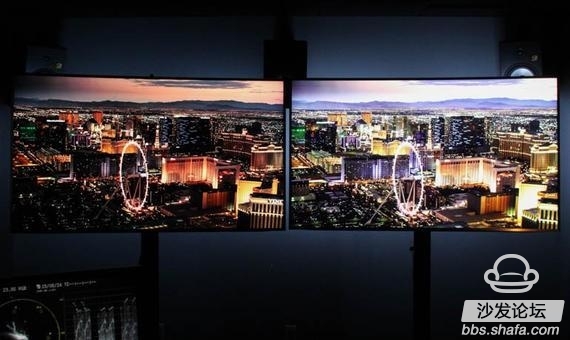
HDR, or high dynamic range, will be the next big thing in the TV world. After years of preparation, a number of TVs supporting HDR have entered the market, HDR-compatible TV dramas and movies are also available for online viewing, and HD Blu-ray discs with HDR capabilities are coming soon. If you don't know much about this important technological change, the introduction of the technology website CNET a few days ago should make you look forward to it.
What is high dynamic range?
The two most important criteria for measuring the quality of a television are contrast and color. If we compare two televisions together, the former has better contrast and more accurate colors, while the latter only has higher resolution, then almost every viewer will think that the former's picture quality is better. Although the resolution is lower, the higher contrast and color accuracy make the picture look more natural and realistic. In other words, a 1080p resolution TV with excellent resolution and color is definitely more popular than a 4K TV with contrast and color performance.
HDR can significantly expand the contrast and color at the same time. The bright part of the picture will be brighter, making it look more "deep"; and the color of the extension can make red, green and blue and all colors between them look brighter and pure. In addition, the wide color gamut (WCG) will come along with HDR, which greatly expands the color that TV screens can present.
Different HDRs
The HDR function of the TV is not the same as the HDR function we used to take pictures. The two are actually very different. This is the point we most need to understand. As mentioned above, the former can expand the contrast and color of the TV to present a more realistic and natural picture effect, while the latter combines different exposed images to simulate a larger dynamic range.
An HDR photo is not really a true "high dynamic range," nor is it capable of real HDR. Its dynamic range does not actually change, but the extra exposure brings additional information.

However, the HDR image of the TV does not look the same as the HDR photograph, but only enhances the image quality.
Way of working
The HDR system consists of two parts: television and content sources. To be compatible with HDR, TVs need to be able to generate more light in specific areas of the image, just like local dimming, but only to a higher degree.
There is also a wide color gamut associated with HDR. In these years, TV has been able to exhibit the largest possible color range in Blu-ray or HD content downloads. The problem is that you don't really want TV to produce these colors indiscriminately. We should let the director decide what kind of color his movie or TV show should have, instead of letting his own color processing unit decide.
Of course, it is costly to enhance the brightness and color of television. The HDR TV's image quality performance is always high and high. Therefore, we cannot say that HDR-compatible TVs are necessarily stronger than ordinary TVs. The only significance of the HDR tag for TV is to indicate that it can display HDR content.
True, content is a more difficult issue. HDR TVs require HDR content to highlight their value, and the latter is almost nonexistent. TV shows and movies with 4K resolution are rare, let alone HDR content. At present, only Amazon's streaming service has some HDR resources, and the number is very limited. In addition, Netflix said that they will launch HDR content before the end of the year. In addition, other content providers have not announced their plans for HDR content.
The physical disk is another source of HDR content. The ultra-clear 4K Blu-ray parameters allow the disc to carry the HDR version while providing Dolby Vision options. But the question is: How many Blu-ray products we will see in support of HDR, especially at the beginning?
Content is key
When making a movie or television, the director and photographer will work with colorists to choose the right color for different scenes. For example, in the game of HBO's hot episode power, the winter-cold Winter City and the warm and fertile King are each showing two different shades of coolness and warmth.
While shooting a movie, the shooting team can use the extensive Digital Cinema P3 color standard to achieve elegant blue-green, orange and blue-purple colors. In order for these movies to play on TV, the production team will generally remove the dynamic range and limit the color. Considering the high-definition television system

The limitations of the system, they will change the way they want, and the final limited version is what we see in the Blu-ray Disc or download file.
If you put the TV in the movie mode, this is basically the effect you will see at home. In the dynamic mode, the TV exaggerates the colors of the screen in ways that it deems appropriate to present colors that were not originally present in the content. Because in the post-production stage, the director and his team must remove these colors. So is this "dynamic" version closer to what you see, or is it being shown in a movie theater? This is impossible to judge, because these are all made out of your television.
With the extra brightness storage and transmission capabilities, 4K Blu-ray and video streaming can add extra HDR data (metadata) to the signal. It will tell HDR/WCG what the TV picture should look like. Those colors should be deeper, and what the specific brightness of highlights, reflections, stars, the sun and blasting should be. It can even adjust picture settings or automatically change to a specific picture mode. This is obviously a huge step forward.
Need to replace the cable?
The current high-speed HDMI cable can already carry HDR content, but playback devices (such as 4K Blu-ray players) and TVs must support the HDMI 2.0a standard to transfer metadata. The good news is that many HDMI 2.0 devices released this year can support HDMI 2.0a through firmware upgrades. Unlike the HDMI standard transition from 1.4 to 2.0, there is no hardware limitation for the 2.0 upgrade to 2.0a. If you purchased an HDMI 2.0 device this year, you should be concerned if the vendor has released a firmware upgrade.
to sum up
Many experts in the television and content fields are looking forward to HDR and WCG. It's cool to see the 4K pixel resolution increase, but the amazing picture quality makes us even more amazed. With the help of HDR and WCG, the TV field is about to usher in a veritable evolution.
All black solar panels or black frame Solar Panel, power range around 400w to 460w which is higher solar panel efficiency the front black or front and back are both black.
All black solar panel data
| mono type | mono crystalline half cut cell |
| power range | 400watt to 460watt |
| dimensions | 1176*1134*30mm |
| type | monofacial type or bifacial type |
Product details and pic


All Black Solar Panel,Trina Solar Panel Vertex S,Mono Crystalline Pv Modules,Full Black Solar Panels 420Watt
PLIER(Suzhou) Photovoltaic Technology Co., Ltd. , https://www.pliersolarpanel.com